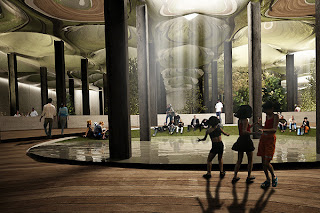美國紐約曼哈頓下東城的迪南希街地底,其實有占地六萬平方英尺的拱形屋頂及鵝卵石街道,卻都閒置在漆黑之中無人聞問,「威廉斯堡橋」鐵路總站於1948年停用,如今一群企業家看上這塊地方,打算讓自然光灑落在車站內,改建為地下公園。
這項技術是由建築師兼計畫共同發起人朗西(James Ramsey)研發,確切內容在規劃圖曝光之前皆為機密,不過他曾提到,會運用光纖管線導引日光。
對於這些不尋常的構想,紐約居民是否會一如過往樂於接受?自從「高架公園」第二期於七月完工後,紐約對公園的要求與標準變得極高,「高架公園」原本是拆除在即的廢棄高架鐵道,如今卻像一條綠色腰帶,蜿蜓在街道之上。
「高架公園」再開發案不僅保留紐約工業遺跡,每年更吸引近600萬人次造訪,進而帶動費城、芝加哥及鹿特丹效法。
迪南希街地底公園構想聽來肯定比「高架公園」大膽,但能否行得通?朗西堅定地表示,「這完全是個怪異又有趣的構想,但我認為相當合理」,不過英國倫敦大學學院都市再生專家卡拉迪米崔(Nikolaos Karadimitriou)博士指出,還有許多疑問尚未解答,例如「這項計畫能否創造收益?收入來源為何?」。社區支持是當初高架公園成功的關鍵,對這項計畫亦然,若能成真,這項「怪異又有趣的構想」將為下東城帶來一處獨特綠色空間。
The world’s first underground park moves a step closer to reality on Friday, when a public funding drive for an innovative design proposal closes.
A plan to build the LowLine, a vast, subterranean public space in New York’s Lower East Side, has has attracted donations totalling more than $150,000 on the funding website Kickstarter since 22 February.
The deadline closes at 5.46pm on Friday, with the initial $100,000 target easily surpassed. By far the most pledges have been for between $10 and $50.
Dan Barasch and James Ramsey will then be able to get to work on the first stage of the LowLine – a scale model of the park, constructed in an abandoned warehouse steps away from the underground location.
“We’re tremendously delighted that what we’ve been able to do is get a pretty significant amount of online enthusiasm for the idea,” Barasch said. “If you look closely at that campaign, it’s over 3,000 individual supporters.”
The idea for the LowLine came after Ramsey, a New York-based designer, learnt about New York’s underground spaces from an MTA employee.
“There’s 13 acres of these kind of spaces underground that are unused,” Barasch said. “One of the more interesting locations was this trolley terminal that transit people and people who know a lot about the underground would know about this site, but the average person wouldn’t.”
The underground space is a 1.5 acre terminal built in 1903 for trolley trains to shuttle passengers between Brooklyn and Manhattan across the newly-opened Williamsburg bridge. When the trolley service ended in 1948, the terminal closed, and it has lain dormant since.
The name for the park originated from another innovative New York public space: the High Line, a park based on an elevated railroad on the west side of Manhattan.
With no natural light, the underground terminal in the Lower East Side may not seem the most natural location for what Barasch and Ramsey hope will become a “year-round public space”, supporting farmers markets, concerts and art installations, but the LowLine will rely on fiber optic cables to transfer sunlight below ground.
The system will capture and concentrate sunlight above ground before beaming it into the park below, with the design proposal promising that the light will even “carry the necessary wavelengths to support photosynthesis”, meaning plantlife can flourish below ground.
The lease to the underground terminal is owned by the Metropolitan Transit Authority, which manages public transport in New York. The money raised through KickStarter will be used to build a small-scale model of the park, opening in September, in the disused Essex Street Market in the Lower East Side, in a bid to demonstrate to the MTA that the idea for the LowLine can work.
“2012 is the year of gaining public support for the idea and hopefully gaining the official rights to proceed,” Barasch said.
“That effort is really geared towards building a business model that the MTA will find attractive financially. That’s really what we’re focussed on this year. Our goal is that hopefully after the end of this year, having commissioned and gained access to the possibility of actually building in there, that we can move quickly.”
As for how long it will take before city-dwellers can relax in the underground park, Barasch is hopeful the LowLine could open this decade.
“The High Line took ten years,” Barasch said. “We’re hoping we can move much more quickly, and even do this within the next five years if we can.”












































